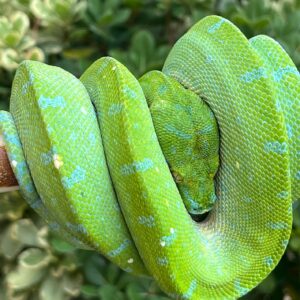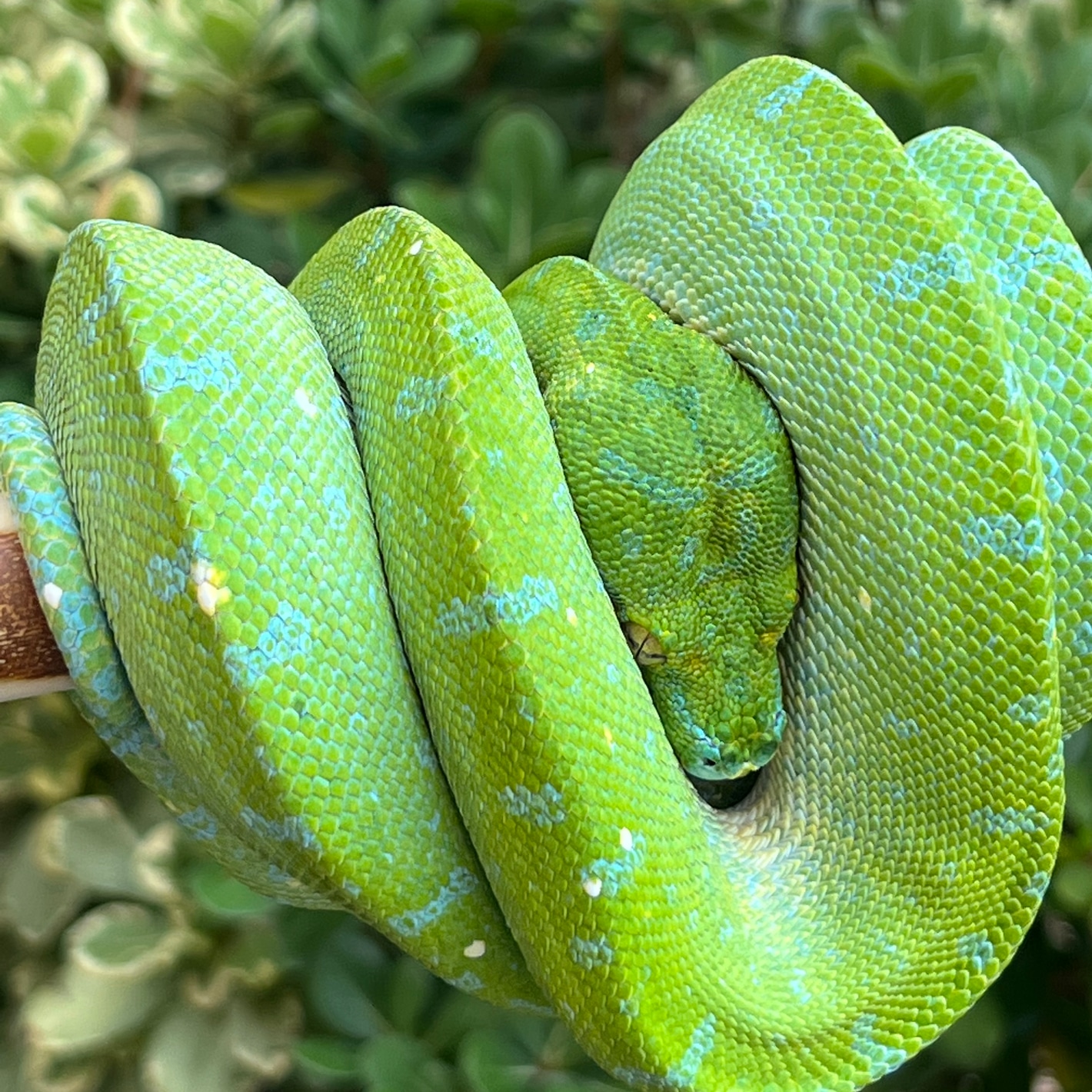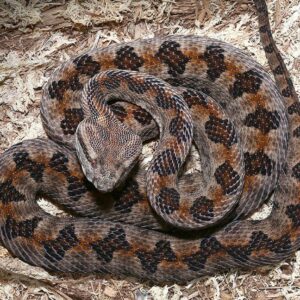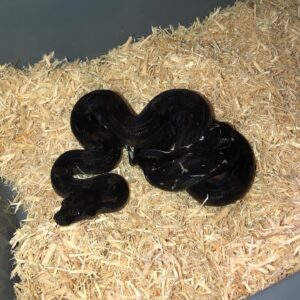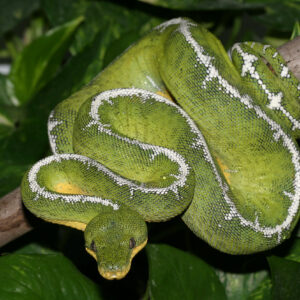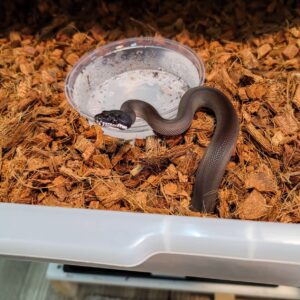Biak Green Tree Python For Sale
$499.99
Biak Green Tree Python
- Approximate sizes: sizes vary, Farm Bred are approximately 2 to 4 feet long. Reaches full adult size of 4 to 6 feet in approximately 48 months.
- Captive Bred
- Sturdy and long lived – over 15 years in captivity.
- Biak Green Tree Python are NOT for children but experienced reptile hobbyists enjoy this species greatly.
- Captive bred GTP are not aggressive BUT they do require careful handling.
- Handles fine once acclimated to being touched by its owner.
- Unless otherwise noted, picture and video shown are a representation of this animal. As this is a live animal, there will be aesthetic variations.
Green tree pythons eat small mammals and other reptiles, such as frogs, birds, lizards, and bats, especially those found in trees.
Biak Green Tree Python are also known to eat ground-dwelling rodents1. They use their sense of smell to locate prey and are excellent climbers. As juveniles, they are diurnal and more active during the day.
They are obligate ambush predators and will lure prey close by wiggling the tip of their tail, mimicking a worm, before striking and constricting their prey. When kept as pets, they are often fed a diet that primarily consists of rats and mice
Description
Biak Green Tree Python
The Biak Green Tree Python (Morelia viridis) is a captivating species within the reptile kingdom, garnering significant interest among herpetologists and reptile aficionados. This python, also known as the Biak Tree Python or Biak Island Green Python, is native to Biak Island, part of the Indonesian archipelago. Its scientific classification places it within the family Pythonidae, a group renowned for its diversity and adaptability.
Biak Green Tree Pythons thrive in the dense, humid rainforests of Biak Island. This lush environment provides the perfect backdrop for their unique adaptations. These pythons are arboreal, meaning they spend the majority of their lives in trees. Their prehensile tails and slender bodies are well-suited for navigating the forest canopy, where they hunt for small mammals and birds.
One of the most striking features of the Biak Green Tree Python is its vivid coloration, which ranges from bright green to yellow, often with a mix of blue and white scales. This coloration not only provides excellent camouflage among the foliage but also makes them highly sought after in the pet trade. Moreover, their ability to change color as they mature—from a juvenile red or yellow to an adult green—is a subject of fascination for both scientists and reptile enthusiasts.
The Biak Green Tree Python’s behavior and physiological traits make it a valuable subject of study. Its nocturnal habits, unique feeding strategies, and reproductive biology offer insights into the adaptability and evolution of arboreal snakes. Herpetologists are particularly interested in understanding how these pythons interact with their environment and how they have evolved to thrive in such a specialized niche.
In summary, the Biak Green Tree Python is more than just a visually stunning reptile; it is a remarkable example of nature’s ingenuity. Its adaptations to life in the treetops, combined with its intriguing behaviors, make it a significant subject of study and admiration within the herpetological community.
The Biak Green Tree Python, scientifically known as Morelia viridis, is renowned for its striking appearance and distinctive physical traits. One of the most captivating features of this species is its vibrant green coloration, which serves as an excellent camouflage in its native rainforest canopy. This brilliant green hue, often interspersed with yellow or blue markings, enables the python to blend seamlessly into the leafy environment, providing both predator avoidance and stealth when hunting.
Adults typically reach lengths of 4 to 6 feet, with some individuals growing even longer. The Biak Green Tree Python exhibits a slender, elongated body that is well-adapted for an arboreal lifestyle. Its scales are smooth and shiny, contributing to its sleek appearance and aiding in its movement through the dense foliage. The python’s head is distinctively triangular, with heat-sensing pits located along its lips, allowing it to detect warm-blooded prey even in complete darkness.
One of the most remarkable adaptations of the Biak Green Tree Python is its prehensile tail. This specialized tail acts as a fifth limb, enabling the snake to grasp branches securely as it navigates through the trees. This prehensile ability is crucial for maintaining stability and balance in its arboreal habitat.
Sexual dimorphism is present in the Biak Green Tree Python, with females generally being larger and more robust than males. Males tend to have longer tails relative to their body length, which is an adaptation for their reproductive role. Juveniles of the species exhibit a dramatic color change as they mature. Hatchlings are typically bright yellow, orange, or red, which gradually transitions to the characteristic green as they age. This ontogenetic color change is thought to provide better camouflage for young snakes in their specific environments.
In addition to the typical green morph, there are various color morphs that have been selectively bred in captivity, showcasing a range of hues and patterns. These variations add to the allure of the Biak Green Tree Python, making it a favorite among reptile enthusiasts and breeders.
Behavior and Temperament
The Biak Green Tree Python, known for its vibrant green coloration, exhibits a fascinating array of behaviors and temperamental traits that make it a captivating subject for herpetologists and reptile enthusiasts alike. These pythons are primarily arboreal, meaning they spend most of their lives in trees. This arboreal lifestyle is supported by their prehensile tail, which enables them to navigate through branches with precision and grace. The tail acts as an additional limb, providing balance and stability as they move through their leafy habitats.
Exhibiting nocturnal hunting habits, the Biak Green Tree Python is most active at night. During these hours, it employs its exceptional sense of smell and heat-sensing pits to locate prey. In the wild, their diet primarily consists of small mammals, birds, and occasionally, reptiles. This diverse diet ensures they receive a balanced intake of nutrients necessary for their health and growth. In captivity, their feeding regimen typically includes appropriately sized rodents, which provide a similar nutritional profile to their natural prey.
When it comes to temperament, the Biak Green Tree Python can be somewhat variable. Generally, they are known to be more defensive compared to other python species. This defensive nature can be attributed to their natural instincts to protect themselves from potential predators. However, with regular, gentle handling from a young age, they can become more accustomed to human interaction. It is important for handlers to approach them calmly and confidently to avoid provoking a defensive response.
Interactions with other animals should be approached with caution. Biak Green Tree Pythons can exhibit territorial behavior, especially during feeding times. It is advisable to house them individually to prevent stress and potential conflicts. Understanding their behavior and temperament is crucial for providing a suitable environment that meets their physical and psychological needs, ensuring a healthy and enriching life for these remarkable reptiles.
Habitat and Range
The Biak Green Tree Python, scientifically known as Morelia viridis, is predominantly found on Biak Island, part of the Papua province in Indonesia. This tropical island, with its lush rainforests and diverse ecosystems, provides an ideal setting for these striking serpents. Within this habitat, the climate is characterized by high humidity levels and consistent temperatures ranging between 24 to 32 degrees Celsius, creating a warm and moist environment conducive to the python’s survival.
Biak Island’s extensive vegetative cover includes dense canopies of tropical trees, shrubs, and vines, offering ample opportunities for the Biak Green Tree Python to exhibit its arboreal nature. These snakes are primarily tree-dwellers, spending the majority of their lives coiled around branches, camouflaging seamlessly with the vibrant green foliage. The island’s rich biodiversity also ensures a steady supply of prey, including small mammals, birds, and reptiles, which are crucial for the python’s diet.
Adaptations of the Biak Green Tree Python to its surroundings are fascinating. Their prehensile tails aid in maneuvering through the trees, while their striking coloration provides excellent camouflage against predators and aids in ambushing prey. Additionally, the python’s ability to thermoregulate by moving between sunlit and shaded areas within the canopy helps maintain optimal body temperatures.
However, the natural habitat of the Biak Green Tree Python faces significant threats, primarily due to deforestation and habitat fragmentation. Logging activities and land conversion for agriculture and human settlements have led to the degradation of vast forested areas on Biak Island. Such environmental disturbances not only reduce the available habitat for these pythons but also disrupt their ecological balance, making them more vulnerable to predation and decreasing their prey availability.
Conservation efforts are vital to protect the Biak Green Tree Python’s habitat. Preserving the rainforests of Biak Island and implementing sustainable land-use practices can mitigate the adverse impacts of deforestation. Raising awareness about the ecological importance of this species and its habitat can also foster community involvement in conservation initiatives, ensuring the survival of these magnificent pythons for future generations.
Reproduction and Lifespan
The Biak Green Tree Python (Morelia viridis) exhibits fascinating reproductive behaviors and lifecycle stages that are integral to its survival and propagation. The breeding season for these pythons typically occurs during the wet season, which provides optimal environmental conditions for mating and egg development. During this period, males engage in combat to win the favor of receptive females. The mating process involves a complex courtship ritual where the male uses his cloacal spurs to stimulate the female, leading to copulation.
After successful mating, the female Biak Green Tree Python will lay a clutch of eggs, generally ranging from 10 to 25 eggs. She lays them in a secure, humid environment, often within hollows of trees or under dense foliage. The female exhibits maternal care by coiling around the eggs to protect them and maintain the necessary temperature and humidity levels. The incubation period lasts approximately 45 to 60 days, depending on environmental conditions.
Upon hatching, juvenile Biak Green Tree Pythons display a significant color variation compared to adults, often emerging with bright yellow or red hues. These colors gradually shift to the characteristic green as they mature. The growth stages from juvenile to adult involve several molting cycles, during which the snake sheds its skin to accommodate its increasing size. This process continues until they reach full maturity, which typically occurs around three to four years of age.
In terms of lifespan, Biak Green Tree Pythons can live for a considerable period. In the wild, their lifespan averages around 10 to 15 years, influenced by factors like predation, habitat conditions, and food availability. However, in captivity, with optimal care, these pythons can live up to 20 years or more. Proper husbandry, including a well-maintained enclosure, a balanced diet, and regular health check-ups, plays a crucial role in extending their lifespan in captivity.
Conservation Status
The Biak Green Tree Python, a remarkable and vividly colored reptile, holds a unique place in the ecosystem of its native habitat. According to the International Union for Conservation of Nature (IUCN), this species is currently not classified as endangered or threatened. However, it is crucial to recognize that the Biak Green Tree Python faces several challenges that could impact its population in the long term.
One of the primary threats to the Biak Green Tree Python is habitat loss. The tropical rainforests of Biak Island, where this species is predominantly found, are under continuous pressure from deforestation and land development. This loss of habitat not only reduces the available living space for these pythons but also disrupts their prey availability, leading to potential declines in their population.
In light of these challenges, various conservation efforts are being undertaken to protect the Biak Green Tree Python. Habitat preservation initiatives are at the forefront of these efforts. Organizations and local governments are working together to establish protected areas and implement sustainable land-use practices that minimize deforestation and promote the conservation of tropical rainforests. These measures are essential to ensure that the natural habitat of the Biak Green Tree Python remains intact and capable of supporting healthy populations.
Additionally, breeding programs play a vital role in the conservation of the Biak Green Tree Python. These programs aim to maintain genetically diverse captive populations that can potentially be reintroduced into the wild if necessary. By ensuring a stable captive population, conservationists can help safeguard the species against unforeseen environmental changes and further habitat loss.
Overall, while the Biak Green Tree Python is not currently classified as endangered or threatened, proactive conservation efforts are essential to ensure its continued survival. By focusing on habitat preservation and breeding programs, we can help protect this captivating species for future generations to appreciate and study.
Care and Husbandry in Captivity
Successfully keeping a Biak Green Tree Python in captivity requires meticulous attention to their specific needs. First and foremost, the enclosure should mimic their natural habitat. A vertical-oriented terrarium of at least 36 inches tall is essential, as these arboreal snakes thrive in environments that allow climbing. Equip the enclosure with branches, perches, and foliage to provide adequate climbing and hiding opportunities.
Temperature regulation is crucial for Biak Green Tree Pythons. The enclosure should maintain a gradient, with a basking area at 88-92°F and a cooler region around 75-80°F. Nighttime temperatures can drop slightly, but should not fall below 70°F. Using a thermostat-controlled heat source like a ceramic heat emitter or an under-tank heater ensures stability. Additionally, maintaining humidity levels between 50-70% is vital. Regular misting and a substrate that retains moisture, such as cypress mulch or sphagnum moss, can help achieve optimal humidity.
In terms of diet, Biak Green Tree Pythons primarily feed on rodents in captivity. Juveniles should be fed appropriately sized pinkie mice every 5-7 days, while adults can be fed larger prey such as adult mice or small rats every 10-14 days. Ensure the prey size is no larger than the widest part of the snake’s body to prevent regurgitation and other digestive issues.
Common health issues in Biak Green Tree Pythons include respiratory infections, parasitic infestations, and skin problems. Regular veterinary check-ups and maintaining a clean, stress-free environment can mitigate these risks. Signs of health problems include lethargy, wheezing, and irregular shedding patterns. Immediate consultation with a reptile veterinarian is recommended if any symptoms arise.
Handling Biak Green Tree Pythons should be approached with caution. These snakes can be defensive and may bite if they feel threatened. Always handle them gently and support their entire body to reduce stress. Limit handling to brief periods to avoid undue stress and ensure the snake’s well-being.
Biak Green Tree Python in Culture and Research
The Biak Green Tree Python, a vibrant and visually striking reptile, holds a significant place in both cultural narratives and scientific research. In the local cultures of the Biak Islands in Indonesia, these snakes are often surrounded by myths and legends. They are frequently depicted in folklore as guardians of the forest, embodying the spirit of the lush, tropical environment they inhabit. These stories have contributed to a veneration of the species, underscoring its importance in the region’s cultural tapestry.
In the realm of scientific research, the Biak Green Tree Python has been the subject of numerous studies aimed at uncovering various aspects of reptile biology and ecology. One key area of research has been the species’ unique coloration and patterning. Scientists have explored the genetic mechanisms behind their striking green hue, which is believed to aid in camouflage within the dense foliage of their native habitat. These studies have provided valuable insights into the evolutionary adaptations of arboreal reptiles.
Moreover, the Biak Green Tree Python has contributed significantly to our understanding of reptilian physiology and behavior. Research on their thermoregulation strategies has revealed how these snakes maintain their body temperature within optimal ranges, an essential trait for survival in fluctuating environmental conditions. Additionally, studies on their predatory tactics and dietary preferences have shed light on their role in the ecosystem as both predator and prey.
Field studies have also focused on the Biak Green Tree Python’s reproductive biology. Observations on mating behaviors, clutch size, and parental investment have offered a deeper comprehension of their life cycle and reproductive success. These findings not only enhance our knowledge of the species but also inform conservation efforts aimed at preserving their natural habitats and ensuring their survival.
Overall, the Biak Green Tree Python serves as a vital link between cultural heritage and scientific inquiry. Its presence in local myths and its contributions to research underscore the multifaceted significance of this remarkable species. Through continued study and conservation, we can ensure that the Biak Green Tree Python remains an integral part of both natural and cultural landscapes.
